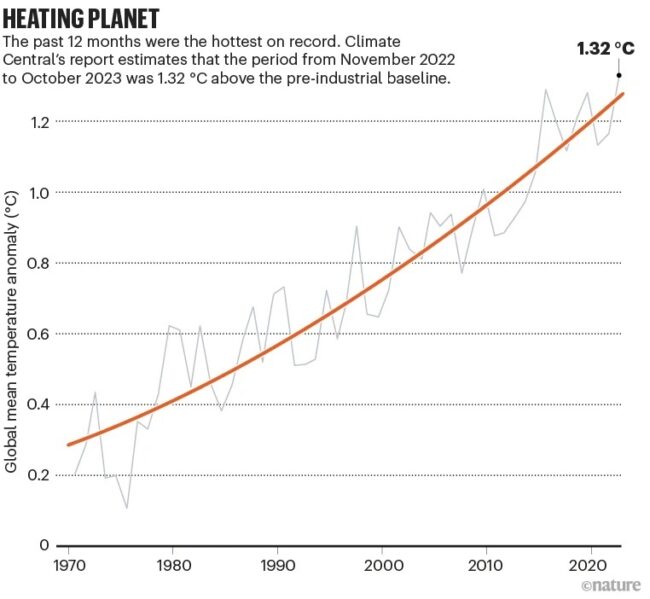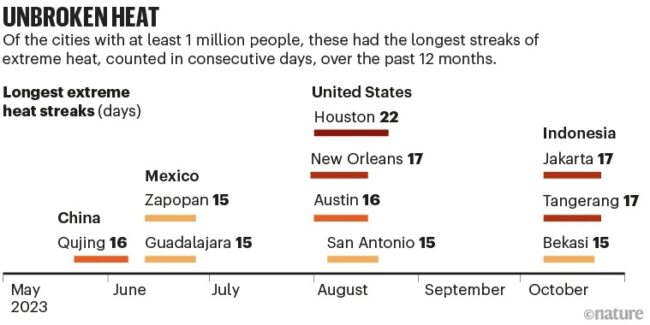Around 7.3 billion people faced temperatures strongly influenced by global warming over the past year, yes climate change is to blame. The past 12
Around 7.3 billion people faced temperatures strongly influenced by global warming over the past year, yes climate change is to blame.
The past 12 months were the hottest on record. Some 7.3 billion people worldwide were exposed, for at least 10 days, to temperatures that were heavily influenced by global warming, with one-quarter of people facing dangerous levels of extreme heat over the past 12 months, according to a report by the non-profit organization Climate Central, reported Nature.

“These impacts are only going to grow as long as we continue to burn coal oil and natural gas,” says Andrew Pershing, the vice- president for science at Climate Central.
Researchers have previously estimated the influence of climate change on specific extreme weather events, a process known as climate attribution. Now, scientists have calculated the impact of human-induced climate change on daily air temperatures in 175 countries and 920 cities from November 2022 to the start of October 2023, reported Nature.

They found that the average global temperature over the past 12 months was 1.32ºC above that during the pre-industrial baseline period of 1850 to 1900, surpassing the previous record of 1.29ºC that was set from October 2015 to September 2016 (see ‘Heating planet’). The report comes as the European Union’s Copernicus Climate Change Service predicted that 2023 will be the hottest calendar year on record, with the average temperature up to October being 1.43ºC above the pre-industrial average.
“This is the hottest temperature that our planet has experienced in something like 125,000 years,” says Pershing, the vice-president for science at Climate Central, reported Nature.
Most of this warming, about 1.28ºC, results from human-induced climate change, with natural variation in the climate caused by processes such as the ongoing ocean-warming event El Niño contributing much less, says climate researcher Friederike Otto at Imperial College London.

By analysing daily air-temperature data and using computational climate models, the team calculated the effect of climate change on daily temperatures worldwide using a measure called the Climate Shift Index -CSI-. The CSI scale runs from –5 to 5. A CSI value of zero means there is no detectable influence of human-caused climate change on the daily temperature, whereas a positive CSI value indicates how much more likely climate change made the daily temperature. A negative CSI value means climate change made the observed temperature less likely, reported Nature.
The researchers found that 7.3 billion people worldwide were exposed, for at least 10 days, to temperatures that were strongly impacted by climate change. In the first half of the past 12 months, tropical regions across South America, Africa and the Malay archipelago experienced the most days with temperatures that were strongly attributable to climate change, defined as having a CSI value of three or higher. These effects were felt even more strongly in the second half of the year-long period.

In Jamaica, the country where global warming had the greatest impact on daily temperatures, people experienced temperatures that were made over 4.5 times more likely by climate change. Guatemala and Rwanda also experienced temperatures that were made more than four times more likely by climate change, reported Nature.
The researchers also estimated the extent to which 700 cities with populations of at least 1 million experienced extreme heat over the past 12 months, defined as daily temperatures that are expected to occur less than 1% of the time in that region. They did this by comparing recent temperature data with data collected over a reference period of 1991–2020.
The team found that:
- 156 cities
- In 37 countries experienced
- Five or more consecutive days of extreme heat
- 144 cities experiencing temperatures that were made at least 2 times more likely by climate change

Houston, Texas, had the longest heat streak of 22 days. This was followed by Jakarta, New Orleans, Louisiana, Tangerang in Indonesia and Quijing in China where people faced at least 16 days of extreme heat in a row (see ‘Unbroken heat’).
Numbers worldwide:
- 1.9 billion people that is
- 24% of the world’s population endured
- 5 consecutive days of extreme heat
Extreme heat, along with flooding and droughts, is often deadly and displaces thousands of people. “By continuing to burn fossil fuels the way we do, it’s a massive violation of the really basic human rights of the vast majority of the planet”, says Otto, reported Nature.

“Next year, El Niño, which is projected to last until at least April 2024, will push temperatures even higher”, says Pershing.
The findings highlight the need to phase out fossil fuels, say researchers. “If we don’t phase out fossil fuels now and stop burning them imminently, this will be a very cool year soon,” says Otto, reported Nature.

“This is a really appreciated effort, it’s great in that this approach can provide continuous updates on the hottest 12 months, not just the hottest –calendar- year, so that hopefully helps to raise awareness of climate change’s impacts each month”, says climate researcher Karsten Haustein at Leipzig University.
This study clearly provides robust evidence for the science of climate-change attribution, says climate researcher Cecilia Conde at the National University in Mexico.
Joyce Kimutai, a meteorologist at Kenya Meteorological Department in Nairobi, says the analysis underscores the urgent need for countries to take action. Kimutai adds that at the United Nations COP 28 climate summit this month, the world needs to make progress on phasing out fossil fuels and implementing the Loss and Damage fund through which richer countries have agreed to help poorer countries cope with the social and physical devastation caused by climate change, as reported Nature.
All Credit To: https://www.nature.com/



COMMENTS